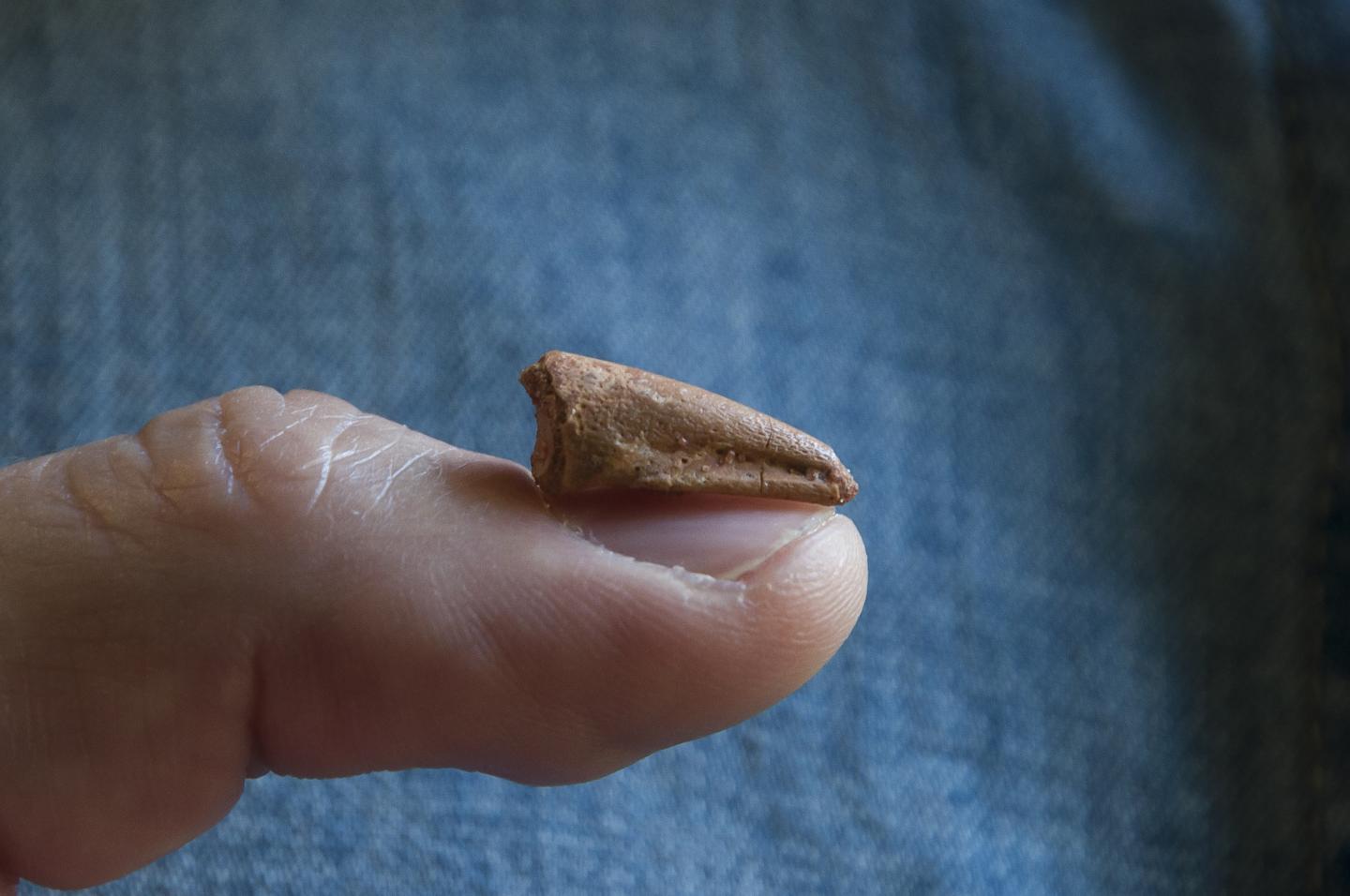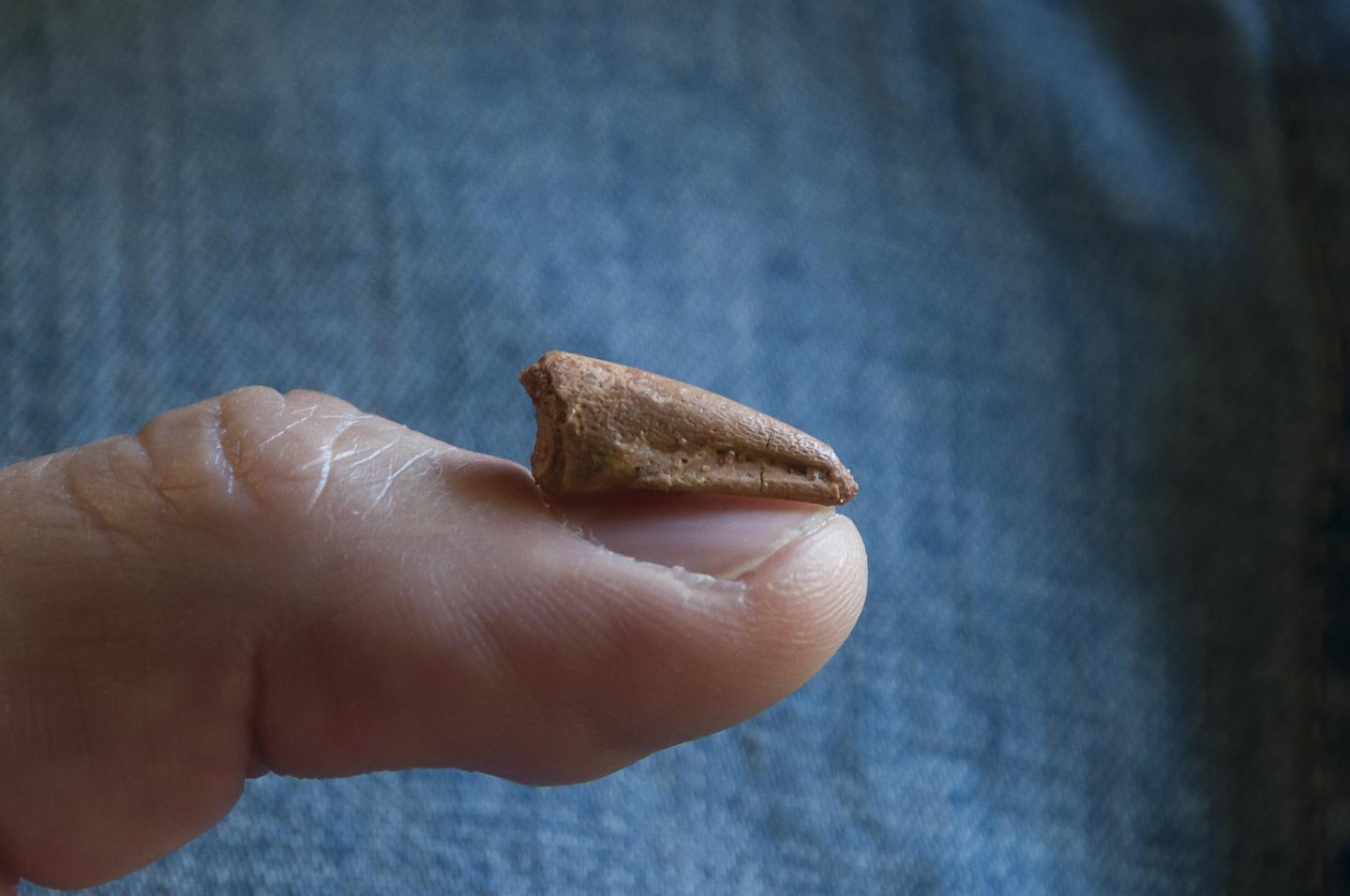
Credit: G. Bindellini
Spinosaurus is the longest, and among the largest predatory dinosaurs, and possesses many adaptations for a semiaquatic lifestyle. A tiny claw phalanx of the foot, discovered in Cretaceous-aged sandstones of the Sahara, shows a peculiar shape compatible with an early juvenile Spinosaurus. As reported in PeerJ – the Journal of Life & Environmental Sciences, the fossil is from the smallest known individual of this giant, sail-backed theropod. The findings suggest the small specimen retains the same locomotor adaptations as the large version – such as traversing soft substrates or paddling – during the entire lifespan.
Collected in Morocco in 1999, a 21 mm-long pedal ungual phalanx (a phalanx supporting a claw of the foot) remained unnoticed in the Paleontological Collection of the Natural History Museum of Milan, until the recent discovery (2014) of a new partial skeleton of Spinosaurus aegyptiacus, that preserves an almost complete right foot with peculiar morphology in the phalanges.
The striking similarities with the claw phalanges of the foot of Spinosaurus allowed palaeontologists Simone Maganuco and Cristiano Dal Sasso to identify the tiny bone to a very small and young specimen of the sail-backed Spinosaurus, the smallest individual reported up to today. "Besides the rarity of the fossils belonging to juvenile theropod dinosaurs, and the rarity of Spinosaurus bones, this finding is even more remarkable if we consider the dramatic size attained by some large specimens of Spinosaurus, which are possibly the longest, and among the largest predatory dinosaurs ever found"- says Maganuco.
Assuming the juveniles looked like smaller versions of the adults, the 21 mm-long claw phalanx from this small specimen would pertain to an early juvenile individual, 1.78 m-long, only just a little bit longer than the estimated length of the sole head of the largest adult Spinosaurus known to date, which is also housed at the Natural History Museum of Milan.
According to recent studies, the broader than deep unguals in Spinosaurus with their flat plantar surface are reminiscent of the flattened pedal shape of shorebirds that do not perch, and the whole foot may have been adapted to traversing soft substrates or webbed for paddling. "This find indicates that in Spinosaurus the foot of early juveniles had the same locomotor adaptations observed in large individuals, that were probably achieved early in ontogeny and retained for the entire lifespan", remarks co-author Cristiano Dal Sasso.
###
Full Media Pack including article pdf and images: https://drive.google.com/drive/folders/1sC4W3EVBdgXtCOPV-woyr6HuZ4iX0XYL?usp=sharing
EMBARGOED until 30 May 2018: 7 am EST; 12 midday UK local time; 11 am GMT (i.e. the date of publication)
Link to the Published Version of the article (quote this link in your story – the link will ONLY work after the embargo lifts): https://peerj.com/articles/4785/ your readers will be able to freely access this article at this URL.
About:
PeerJ is an Open Access publisher of two peer-reviewed journals and a preprint server. PeerJ's mission is to help the world efficiently publish its knowledge. All works published by PeerJ are Open Access and published using a Creative Commons license (CC-BY 4.0). PeerJ is based in San Diego, CA and the UK and can be accessed at peerj.com
PeerJ is the peer-reviewed journal for Biology, Medicine and Environmental Sciences. PeerJ has recently added 15 areas in environmental science subject areas, including Natural Resource Management, Climate Change Biology, and Environmental Impacts. peerj.com/environmental-sciences
PeerJ has an Editorial Board of over 1,900 respected academics, including 5 Nobel Laureates. PeerJ was the recipient of the 2013 ALPSP Award for Publishing Innovation. PeerJ Media Resources (including logos) can be found at: peerj.com/about/press
Media Contacts
For the authors:
Simone Maganuco [email protected] +393471868851
Cristiano Dal Sasso [email protected]
For PeerJ: email: [email protected] , https://peerj.com/about/press/
Note: If you would like to join the PeerJ Press Release list, please register at: http://bit.ly/PressList
Media Contact
Simone Maganuco
[email protected]
@ThePeerJ
http://https://peerj.com
Related Journal Article
http://dx.doi.org/10.7717/peerj.4785






